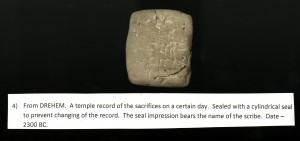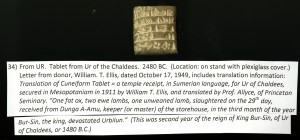 I’ve been telling you about many of the books in our Rare Book Room Collections, and showing you images of many of them. But, this week, I’m going to show you some images of some of the oldest materials we have in the collection…materials dating back to about 2350 BC. Yes, BC, not AD. That would mean that these materials would not be printed works, so what are they? They’re cuneiforms.
I’ve been telling you about many of the books in our Rare Book Room Collections, and showing you images of many of them. But, this week, I’m going to show you some images of some of the oldest materials we have in the collection…materials dating back to about 2350 BC. Yes, BC, not AD. That would mean that these materials would not be printed works, so what are they? They’re cuneiforms.
What are cuneiforms? The Merriam-Webster dictionary defines cuneiform as:
1: having the shape of a wedge
2: composed of or written in wedge-shaped characters
Our cuneiforms are clay tablets from the ancient Mesopotamian area, including the ancient cities of Jokha, Warka, Drehem, Babylon, Ur, and Nippur. Most are small, and are primarily temple records, messenger tablets, butchers’ bills, business memoranda and contracts, and prayer cones.
Some were donated to the library, and others were purchased in the 1930s, at a time when many colleges and universities, and museums were acquiring artifacts from Asia.
Although none of our translated cuneiforms have shed any light on ancient mysteries, or answered any long-unanswered questions, they are interesting in their own right as examples of early writing and human communication.


Speak Your Mind